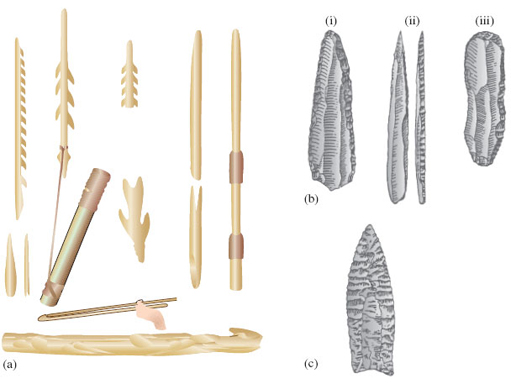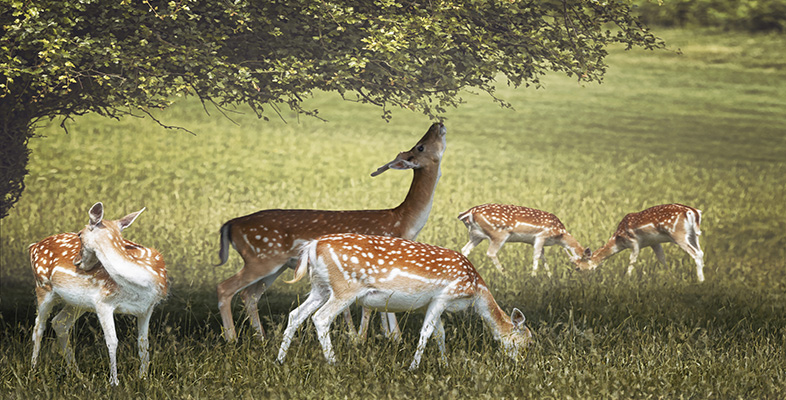6 Modern Homo sapiens
Modern Homo sapiens evolved in Africa about 200 000 years ago, migrating out of Africa over a long period of time. In doing so they colonised much of the world, displacing populations of Homo erectus and other Homo species. The term 'modern' implies that the people were similar to Homo sapiens living today, in both appearance and behaviour. Evidence for an African origin includes the find in Ethiopia of the oldest known H. sapiens fossil, the Omo Kibish skull, dated at 130 000 years old. Fossil H. sapiens dated at 120 000 years old have been found in Israel, suggesting there was relatively little delay in human migration. LoM Chapter 10 offers a brief glimpse of the Cro-Magnon people, the first H. sapiens population to colonise areas now known as France and Spain, about 40 000 years ago.
Question 8
Question: Use the information on the Cro-Magnon art in LoM to summarise the way of life and behaviour of the Cro-Magnon people.
Answer
The example of cave art in LoM p. 301 demonstrates that the Cro-Magnon people were exceptionally skilled artists. The painting depicts a bison, partly disembowelled. A human figure is close to the bison, together with a bird with a spear sticking into it. Other paintings described in the text are of animals with what look like spears in their flanks. Such art suggests that the Cro-Magnon people were skilled hunters.
Such evidence as this suggests that the evolution of Homo sapiens coincided with an unprecedented flowering of art, culture and social behaviour, which some anthropologists explain in terms of an underlying genetic change coincident with an increase in brain size. What else do we know of the way of life of Cro-Magnons? Fossil and artefactual evidence shows that they used caves as shelters. They used fire for cooking; ancient hearths have been found in cave sites containing evidence of occupation by Cro-Magnons. They were skilled toolmakers, using stone to make blades for cutting and slicing animal carcasses and also bone and antler for harpoon-like spears. Figure 8a and b show a range of such Cro-Magnon tools.

The precise timing of the earliest human migrations to what is now America and Canada is the subject of argument. We do know that around 12 000 years ago, during the last Ice Age, people from Siberia crossed the Beringia land bridge and entered what is now called Alaska. They were able to move south by means of an ice-free corridor stretching from Alaska through Canada's Yukon and Northwest territories, to southern North America.
These people, the Clovis, were efficient hunters, using spears tipped with a sharp, fluted stone point, the Clovis point, which is illustrated in Figure 8c. When the Clovis first arrived in America, there were vast populations of indigenous large and giant mammals, including bison, elk, yak and lion. The largest mammals, including mammoth, giant ground sloth and mastodon, became extinct by 10 900 years ago. Some researchers argue that these animals were exterminated by Clovis hunters. Although the numbers of Clovis people were not very large, it was likely that they were killing more animals than they could eat. Other experts argue that massive change in climate at the end of the last Ice Age caused the extinctions.
We will never know for sure how the large mammals became extinct, because the extinctions coincide with both the establishment of modern human populations in the Americas, and the end of the last Ice Age.
There is evidence that as mammoth populations declined, Clovis people switched to hunting bison. Fossil evidence from the Jake Bluff site in Oklahoma, dated at 10 800 years old, indicates that a group of hunters herded about 8-15 bison into a dead- ended gully, an arroyo. Hunters sitting at the top of the arroyo, 3 m above the bison, speared them with Clovis points. The bison were processed at the site, with legs passed up to the top of the arroyo and the main body of the bison processed on the arroyo floor. But the hunting activities of Clovis and succeeding peoples did not have a significant effect on the bison population. Bison were abundant in America and Canada, with numbers estimated at 150-300 million, until the continent was colonised in the 17th to 20th centuries by European settlers. This colonisation was accompanied by a sustained and massive overkill of bison. By 1900, the vast herds of bison had been reduced to 1000 animals, by the activities of a relatively small population of humans.
Some seek to justify the massacre of the bison on grounds of the need to make space for the livestock and arable farms of the European settlers. Farming, accompanied by a more settled lifestyle, had been long established in Europe by the time Europeans arrived in America. In fact, animal and plant domestication had started about 12 000 years ago, in the Near East.
Question 9
Question: Speculate on the possible pressures that resulted in most populations of Homo sapiens becoming sedentary agriculturists.
Answer
Population increase would have resulted in an increased demand for food and the extinction of prey animals. Climate change may have promoted plant growth, making it easier to domesticate food plants such as cereals. Social factors may have contributed too; groups of people found a sedentary way of life more comfortable and compatible with increasing social complexity.
Question 10
Question: Summarise the advantages associated with domestication of plants and animals that are suggested by DA in LoM Chapter 10.
Answer
Domestication of plants and animals enabled humans to settle in permanent communities. By having plant and animal food under their control, human communities were able to increase in size. Division of labour became feasible, with individuals having specific roles within communities, e.g. cloth weaving, pottery making and eventually metal work.
The decline of prey animals and the increasing numbers of people provided the pressure for continuing development of agriculture in most populations. Agriculture is linked to development of towns and cities, because it forces a sedentary existence. Within settled human communities, the culture and hierarchy has become more complex, and food production techniques have had to intensify. As DA demonstrates by his chilling description of the lost Mayan city of Tikal [p. 307], huge populations of cities have to depend on food produced by agriculture. Parallels with modern-day cities are tempting, if only as a reminder of our dependence on intensive and perhaps non-sustainable agricultural practices.
